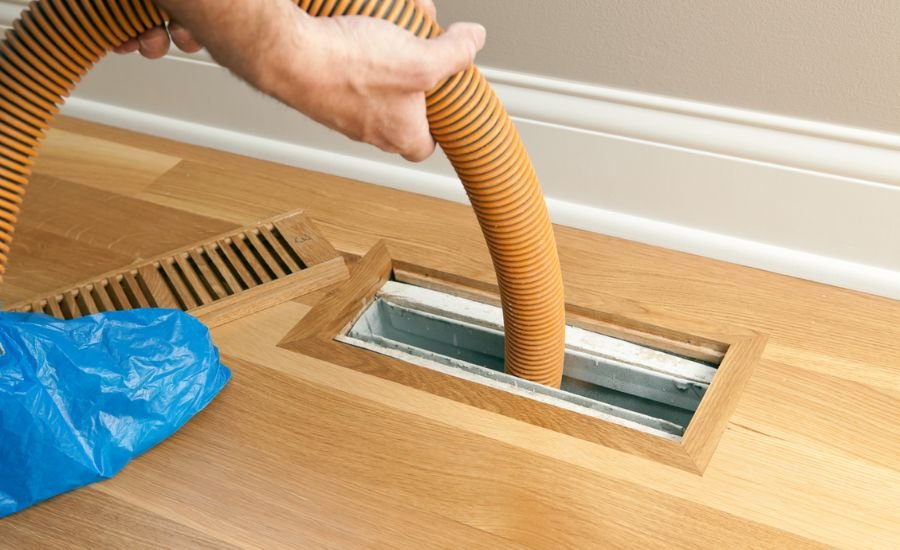How to Clean Home Air Ducts: The Complete DIY Guide to Healthier Indoor Air

Homeowners often overlook one of the most important systems in their home: the HVAC ductwork. These hidden air pathways play a huge role in your comfort, health, and even your energy bills. Over time, dust, mold spores, pet dander, and other particles collect in the ducts, and every time your HVAC system runs, those particles circulate through your entire home. Knowing how to clean home air ducts can help you breathe easier and reduce long-term costs.
If your house feels dusty no matter how often you clean, or your allergies have gotten worse, dirty air ducts may be the culprit. In this complete guide, we’ll explain everything you need to know—from when to clean, how to clean, what tools to use, and even whether to call in a pro. Let’s dive in.
Why You Should Clean Your Home Air Ducts
Your HVAC system constantly moves air throughout your home, and whatever is inside your air ducts gets pushed into every room. This includes dust, pet hair, pollen, insect droppings, and even mold spores. Over time, this buildup can reduce the quality of your indoor air, trigger allergies, and decrease your system’s efficiency.
Regular duct cleaning can help:
- Improve indoor air quality
- Reduce allergens and asthma triggers
- Eliminate unpleasant odors
- Prevent mold growth
- Lower your energy bills by improving HVAC efficiency
- Extend the life of your HVAC equipment
Think of your air ducts like arteries in your body—when they’re clogged, the whole system suffers.
When to Clean Air Ducts in Your Home
It’s not necessary to clean ducts every month, but you should know the signs that it’s time. Your home may need an air duct cleaning if:
- You notice a musty or dusty smell when the HVAC system runs
- There’s visible mold inside ductwork or on vent covers
- Rooms feel stuffy or dust builds up quickly
- You’ve had recent construction or remodeling done
- You’ve moved into a new home and don’t know the duct maintenance history
- You see insects or rodent droppings near air vents
In general, it’s good practice to inspect and clean your air ducts every 3 to 5 years. But light DIY cleanings can be done more frequently to maintain cleanliness.
Read More: A Bold Step into Luxury Sports Sedans
What You Need to Clean Home Air Ducts
You don’t need expensive industrial tools to clean your ducts at home. Here’s a list of tools and their uses:
| Tool | Use |
| Screwdriver | To remove vent covers and access duct openings |
| Vacuum (with hose attachment) | To suction loose dust and debris |
| Long-handled brush | For scrubbing inside the ductwork |
| Microfiber cloths | To wipe and polish grilles and registers |
| Furnace filter (replacement) | To ensure clean airflow post-cleaning |
| Drill-powered duct brush (optional) | For deeper cleaning in long or flexible ducts |
If you’re doing a deep clean for the first time, consider renting a heavy-duty vacuum or purchasing an air duct cleaning kit online. These typically come with long brushes, hoses, and adapters for standard vacuums.
Step-by-Step Instructions on How to Clean Home Air Ducts
Step 1: Turn Off the HVAC System Completely
Before starting, turn off your heating or cooling system at the thermostat and breaker. This prevents the fan from turning on and spreading dust while you clean. It also ensures your safety as you’ll be working near electrical components.
Step 2: Remove the Vent Covers
Carefully remove vent covers and grilles from the walls, floors, or ceiling using a screwdriver. These tend to collect grime and sticky dust. Soak them in warm soapy water while you clean the ducts. After soaking for about 15 minutes, use a cloth or soft brush to scrub them clean. Let them dry completely before reinstalling.
Step 3: Loosen Dust and Debris in the Ducts
Insert your long-handled brush into the duct and gently knock off any dust stuck to the sides. A circular or pushing motion helps loosen stubborn debris. Be cautious around ductwork joints and connections to avoid damaging the material. If your ducts are lined with insulation or flexible plastic, do not scrub too aggressively.
A drill-powered brush can make this easier. These rotating brushes reach further and provide a deeper clean without needing as much manual scrubbing.
Step 4: Vacuum Inside the Ducts
With debris loosened, vacuum the interior of each duct using a hose attachment. Insert the hose as far as possible and slowly pull it back to collect dust. Move the hose around to reach corners and crevices. If you’re using a shop vac, even better—it offers more suction power and can capture fine particles more effectively.
Repeat this process for every duct opening in your home. You may want to cover nearby furniture with cloth or plastic to avoid dust settling during the process.
Step 5: Clean Return Air Vents
Return vents suck air into the HVAC system and typically get dirtier than supply vents. Follow the same steps: scrub with a brush, then vacuum thoroughly. Take extra care if there’s any sign of mold, as this could require professional remediation.
Step 6: Replace Your Furnace Filter
After cleaning, always replace the HVAC system’s air filter. A dirty filter can undo your efforts by pushing more contaminants back into the system. Choose a filter with a high MERV rating (Minimum Efficiency Reporting Value) for better filtration of allergens and fine particles.
How Long Does the Process Take?
Cleaning air ducts in a typical 3-bedroom home may take around 2 to 4 hours, depending on how many vents you have and how dirty they are. The first time may take longer, but with practice and the right tools, it becomes a simple seasonal routine.
How Often Should You Clean Home Air Ducts?
The frequency of duct cleaning depends on your lifestyle and environment. Homes with pets, smokers, or residents with allergies should aim to clean ducts more frequently—once a year is a good rule of thumb for light DIY maintenance. A full professional cleaning may be needed every 3 to 5 years.
DIY vs Professional Air Duct Cleaning
Here’s a deeper look at how DIY duct cleaning compares to hiring a professional service:
| Feature | DIY Cleaning | Professional Cleaning |
| Cost | Low (basic tools) | High ($300–$700) |
| Time | 2–4 hours | 1–2 hours |
| Effectiveness | Good for surface cleaning | Excellent for deep and thorough cleaning |
| Tools | Household vacuums, brushes | Industrial vacuums, compressors |
| Risk of Damage | Low if careful | Very low (trained experts) |
| Best For | Maintenance and minor dust | Severe contamination, mold, pests |
DIY duct cleaning is ideal for keeping your system fresh in between professional services.
Conclusion
Now that you know how to clean home air ducts, you can take a proactive step toward improving your home’s air quality, energy efficiency, and comfort. While hiring a professional is ideal for deep cleaning or mold issues, a careful DIY cleaning once or twice a year can go a long way.
From preparing the tools to understanding when it’s time for a cleanup, this guide equips you with the knowledge to do it right. Clean ducts mean cleaner air—and that’s something every home deserves.
FAQs
Q: Can air duct cleaning help reduce household dust?
A: Yes, clean ducts mean less dust circulating throughout your home. You’ll notice cleaner surfaces and a drop in how often you need to dust furniture.
Q: Is it necessary to clean ducts in newly built homes?
A: Absolutely. Construction dust, wood shavings, and drywall particles often get trapped in the duct system before the home is even occupied. A post-construction clean is highly recommended.
Q: Can dirty ducts cause bad airflow in rooms?
A: Yes. Clogged ducts can reduce airflow to certain rooms, leading to uneven temperatures and increased HVAC strain.
Q: Are scented sprays safe to use in air ducts?
A: Most air fresheners and scented sprays are not designed for HVAC systems and can damage components or leave behind sticky residues. It’s best to stick with HVAC-safe cleaners or avoid fragrances altogether.
Q: Should duct cleaning be part of spring or fall cleaning?
A: Yes, spring and fall are excellent times for duct cleaning. Before major HVAC use in summer or winter, it’s helpful to ensure the system is clean and operating efficiently.
Follow for More Informational Content on CELEBVIBE

Hi there! I’m the admin of Celeb Vibe, a platform where I share engaging and easy-to-read blogs on a wide range of topics. From celebrity news to lifestyle tips, tech trends, and more – my goal is to keep you informed and entertained.




